
In the River TAKAHARA --Vol.72--
A Storm of Sedge
In the beginning of July in 1986 I parked at the heliport at the upper reaches of Dohkanmatu and walked down to the bank of the River Takahara shortly before the evening. There was a famous big deep pool called the pool of the bedrock ahead. The barrier of artificial dam of Kansaka was seen among the mist over the water a little farther upstream. The pool of the bedrock was my memorable spot, where I caught a beautiful yamame trout in the evening of June, 1982, when I first fished this area of the River Takahara. (See vol.17)
In high season the barrier of the artificial dam was filled with sedges everywhere.
The weather had been fine since the morning and the strong sunlight had been pouring on the surface throughout the day. It had been hot but a good amount of the water had cooled the bank before the evening. I planned to fish both the pool of the bedrock and the barrier of Kansaka at the evening rise. Usually only one spot is enough because either spot is so large that it needs a lot of time to fish the whole area. It was greedy of me and no wonder I would end in getting none.
Well, I had confidence. Firstly because I believed that a storm of sedge would come that day. Recently an increasing number of sedges had been hatched in the evening and it was hot that day. I thought: probably the largest number of sedges of the year will be hatched now. If so, they will fly around longer and then drift on the surface longer, which will enable speedy wet fly fishing from the first. That will enable me to fish a large area, too.

Once yamame trout start to eat sedges they rapidly grow up to be big.
Secondly because I had Super Drift rods I had so got used to. The rod surely enabled speedy fishing, however large the pool of the bedrock or the barrier was. Finally, the main reason was that I had Great Sedge, my reliable fly at the peak of sedges’ hatch. I had only to wait for a large amount of sedges to hatch. I was sure about that because small swarms of them started flying here and there in advance of their full-scale flying.
I crossed the shallow current in front of my descending route to the left bank, walked along the bank and stood at the centre of the pool of the bedrock. My plan was to fish the pool of the bedrock first, then move to the barrier of the artificial dam and on my way back fish the pool of the bedrock again. Needless to say, I was ready to change my plan in case other anglers appeared.
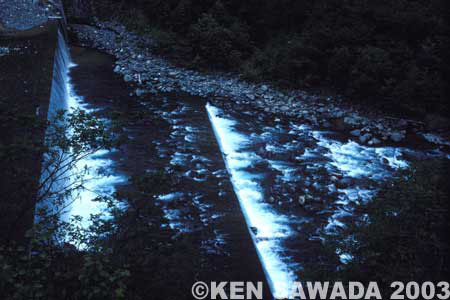
The lower part of the barrier of the artificial dam of Kansaka. (left)
I had a reason to fish the pool of the bedrock first. As this pool lay at the bottom of the gorge, it got dark early. Actually, the right bank was formed by the steep bedrock and the left bank was also covered with steep rocks except for the small corner area. On the other hand, at the barrier of Kansaka, which had wide banks and was open to the sky, it was light. In addition, because of falling water like a white curtain, darkness fell later than other places. It was quite natural to fish such place later.
The pool of the bedrock was a very good-looking point. As the water amount was perfectly good, rises could happen at any spot from the head to the end of the pool. A small swarm of sedges had been flying low above the bedrock near the end of the pool. While I checked the leader very carefully again and again, the swarm gradually swelled up and flew down to the surface slowly. Yes, the first rise must happen here!
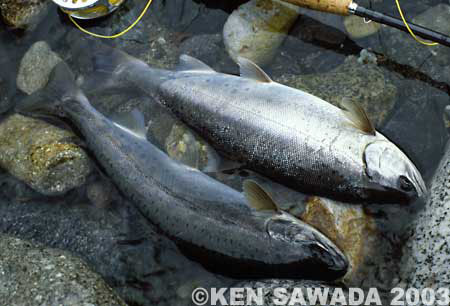
At high season of sedge fish condition also reach their peak.
A Snowstorm
As the swarm of sedges swelled up, an increasing number of them flew low above the surface. Most of them came from downstream, flew between the steep banks to upstream. Some sat on my body on the bank and some bumped on my rod. What a huge number! I looked up at the sky.It looked like a snowstorm at the gorge. Sedges flew all around like falling cherry blossoms in the wind. It was a rare chance to come across such a great swarm of sedges, even though the River Takahara was famous for a large number of sedges. How do they hatch all together? I was fascinated at the scene.
A loud splash! I came to myself. The swarm of sedges flying low above the opposite bank finally came down to the surface and yamame trout made rise to them. Preparing for casting, I stared at the surface in front carefully. Another loud splash! A tension ran around the gorge. My guess was right. But I had no time to boast. I cast the fly towards the opposite bank.
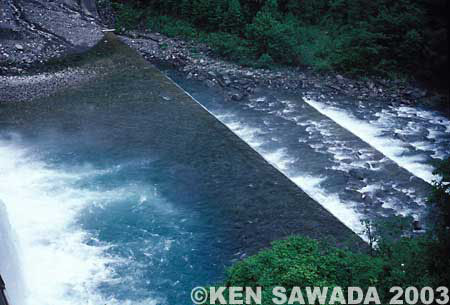
The upper part of the barrier of the artificial dam of Kansaka. We could not fish at high water.
The rise was made a little down the front of my standing point. My fly was passing the very spot now. I held my breath for several seconds and breathed out. Why does no fish bite the fly? At the next moment there was another splash 2m downstream.
A fish over there! Immediately I moved downstream and cast the fly very carefully. Two Great Sedges of size 6 and 8 were crossing the stream. “Come on, now.” But my expectation almost changed into “why not?” when I got a bite with a bang. Immediately I raised the rod. I felt a pull with a dull thud, typical of yamame trout. It was a good response. The fish must be over a trophy size!
I told myself to be calm. I wanted to land it immediately and go to the barrier of Kansaka. But I had to land it without failure. I came here first because I thought that I would be able to catch big fish difficult to land. Actually I was fighting with the fish which bent the rod into a large arc. However, my heart already jumped to the barrier, where big rises were surely made.
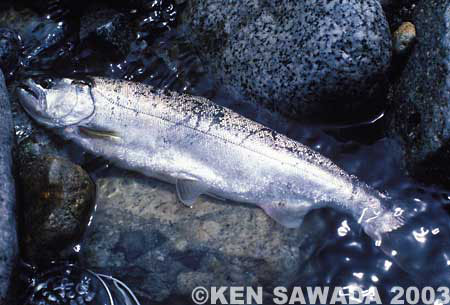
This yamame trout grew up to be as big as a cherry salmon.
Finally the yamame trout came under my feet and I scooped it up. Then I hurried to the barrier. The barrier of Kansaka could be seen very near but I had to walk 50m on the rocky bank. During walking, I thought of the yamame trout I had just caught. It was a beautiful fish of a little over 30 cm and had a high body. In the right corner of its mouth was size 6 Great Sedge.
Usually fish bite the lead fly when we cast down and across, especially at the evening rise. But that yamame trout bit the dropper. Did it happen by chance or did the fish prefer size 6 fly? Or did it choose the fly near the surface? Many questions occurred to me before I got to the lower reaches of the barrier.
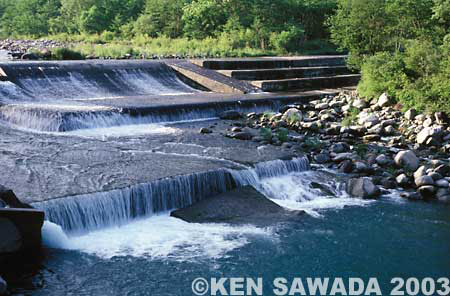
At the lower reaches of the barrier at Imami. Big fish were caught in sedges’ hatch season every year.
Splashes
The barrier of Kansaka had the upper and the lower parts. The water dropped from the upper cascade, overflowed from the pool below and dropped again to form the lower cascade. The lower cascade was about 5m high, shorter than the upper one. The water dropped in a little different way every year but both cascades often had a wide stream at the either side.I decided to fish the lower part because the upper part had too much water. When I stood at the left bank corner countless sedges were flying around. Because of turbulent air near the barrier, a storm of sedges was blowing hard to any direction. Splashes poured down like rain. I could not have stood there only for 10 minutes without raincoat.
There was a small space to the mountain side of the left bank corner of the lower cascade. There lay a piece of driftwood. Over there was a small head of the pool. During the clear daytime it never looked like a good point because it was shallow and covered with thick sand at the bottom. But I knew that fish came there in the dark.
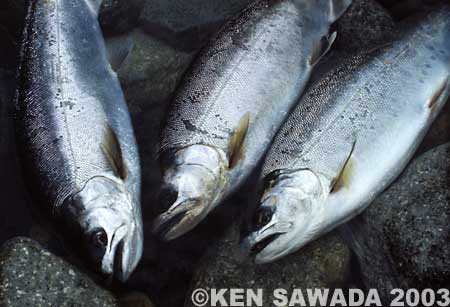
The high time of wet fly fishing came together with the hatch of sedges.
Good timing! It was lighter than the pool of the bedrock although the time had passed since I caught the first yamame trout there. Suddenly a big rise was made in the line of the stream in front of me. No, I can not catch. The water flowed backwards near the tail of the current in the pool down the barrier. Only when the fish came to that part I could fish in the same way of casting down and across. Otherwise, near the line of the stream of falling water, the water flowed directly downstream, which meant I had to hook the upstream-facing fish from below it. That method was not suitable for the sedge-freak fish although I did not deny it was all right with the mayfly-freak fish.
I neglected that big rise in front but cast the fly softly to the shallow bank corner to the mountain side. The water flowed backwards in that space. It meant the water flowed from my feet to the barrier. Experienced bait anglers would fish from on the barrier but I did not because I could stand very near to the fish when it came there.
At the first casting the line slid on the surface and came back to the bank. Both sedges falling on the surface and swimming pupas drifted to the bank, too. That was why clever fish stayed at the very edge of the bank. When the shadow of the line overlapped the bank line I got a bite with a bang. I raised the rod.
Immediately the fish ran at a top speed to the brink of the barrier where the water dropped fiercely. I followed the fish and moved towards the centre of the barrier, feeling lucky that the fish voluntarily left the point.
-- To be continued --
- NET SHOP INFORMATION
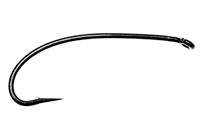
SL6 Black Spey Hooks
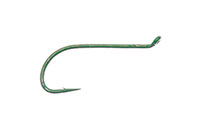
DU3 Limerick Spinner Hooks
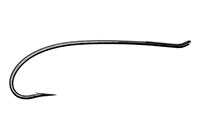
SL4 Single Bartleet Hooks
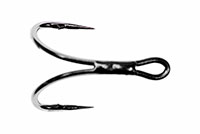
XD1 Tube Fly Double Hooks
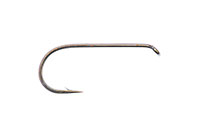
DD2 Flat Perfect Hooks
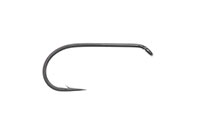
DD1 Black Terrestrial Hooks
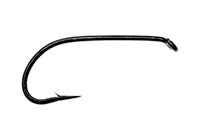
TD4 Old Limerick Wet Hooks
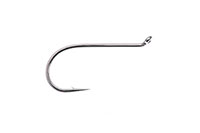
DU1 Silver May Hooks
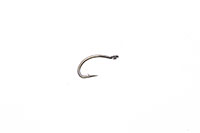
MU1 Flat Midge Hooks
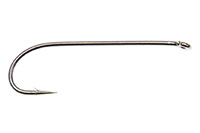
LD3 Long Limerick Hooks
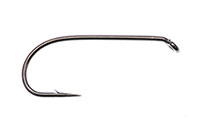
TD2 Summer Sproat Hooks
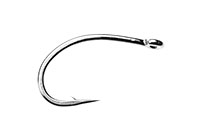
XS1 Tube Single Silver Hooks
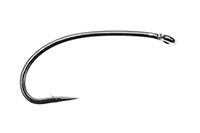
TD6 Siver Sedge Hooks

SL5 Black Spey Hooks

DU3 Limerick Spinner Hooks
- TROPHY CLUB
- FLY SHOW
- EXHIBITION
- MASTERS`
- FLY DRESSING CONTEST Archives
- TRAVELLER Archives
- TACKLE IMPRESSIONS Archives
- ANGLERS` PHOTO GALLERY Archives
- ----------------------------------------------
- トロフィークラブ
- フライショー
- エキシビション
- マスターズ
- フライドレッシング・コンテスト・アーカイヴ
- トラヴェラー・アーカイヴ
- タックル・インプレッション・アーカイヴ
- アングラーズ・フォトギャラリー・アーカイヴ
株式会社サワダ 185-0021 東京都国分寺市南町3-13-4
SAWADA'S INC. 3-13-4 Minamicho, Kokubunji, Tokyo 185-0021, Japan
写真・ドキュメントの無断転載を禁じます。
All the images and documents found on this site are owned by Ken Sawada and may not be used without permission.
But, link to this site is FREE.
Copyright © 2000 - 2025 SAWADA'S INC.. All rights reserved.
SAWADA'S INC. 3-13-4 Minamicho, Kokubunji, Tokyo 185-0021, Japan
写真・ドキュメントの無断転載を禁じます。
All the images and documents found on this site are owned by Ken Sawada and may not be used without permission.
But, link to this site is FREE.
Copyright © 2000 - 2025 SAWADA'S INC.. All rights reserved.
